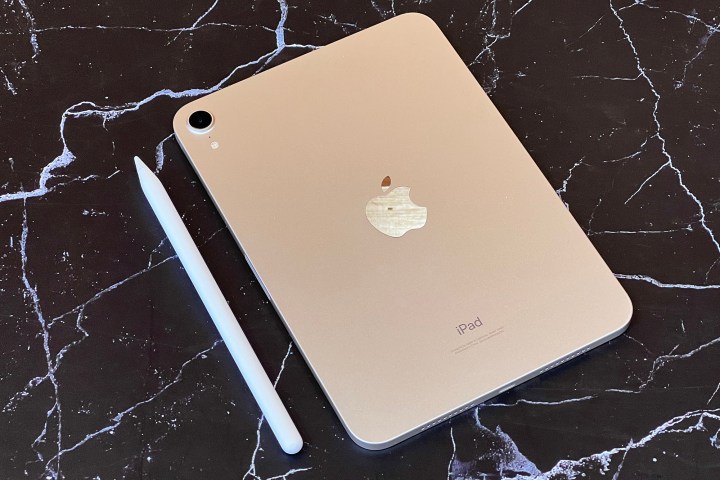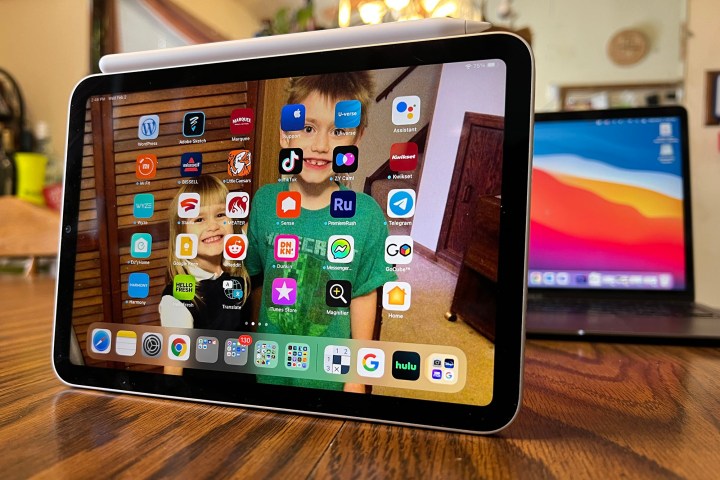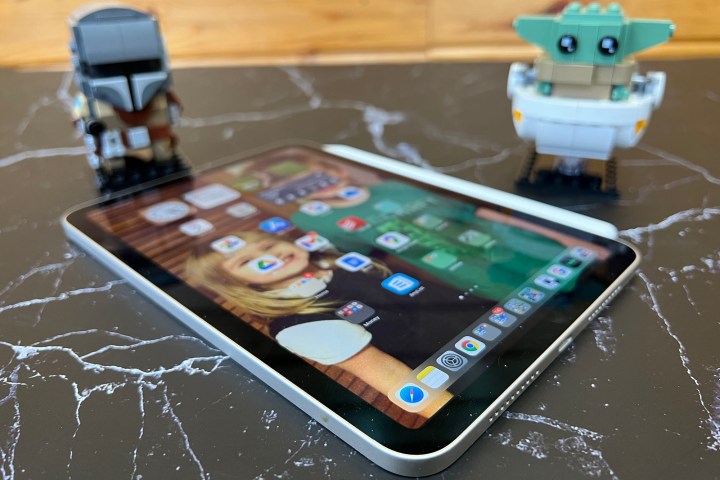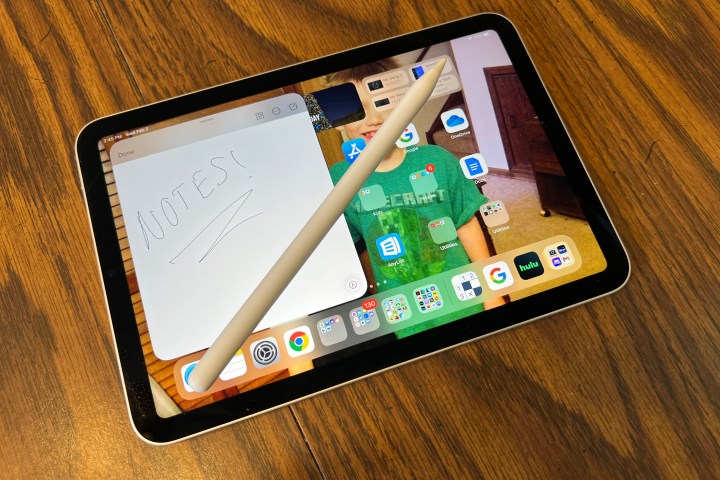“The iPad Mini is officially my favorite iPad ever, and it will do most of the things you want a tablet to do really well.”
- Big enough to perform most tasks
- Compact enough to travel easily
- Powerful performance
- Loud speakers
- USB-C
- Screen is not bright enough
- Too small for content creation
- No headphone jack
When rumors suggested a new iPad Mini was coming last fall, I was excited. My original iPad Mini is a bit long in the tooth, and that’s the main reason I use my newer 10.2-inch iPad. I’ve always loved the iPad Mini for its size and extreme portability. With the latest model, Apple has “Pro-ed” up the iPad Mini by adding the higher-end model’s slim bezels, USB-C port, and fingerprint-sensing power button. It also slapped a $500 price tag on it, putting it more in line with the Pro models than the $329 iPad 10.2-inch in terms of cost.
Naturally, I set out to discover if the “Pro” features on the iPad Mini make it worth the cost of admission. Here are my thoughts.
Hardware and design
As its name implies, the iPad Mini is a smaller version of other iPads out there, but in terms of features, it has more in common with Apple’s Pro and Air series of iPads than the the old-school iPad 10.2.
When the tablet is in portrait orientation, you get the volume up and down buttons on the bottom left, the power/Touch ID button on the upper left, and dual speaker grilles in-between. On the right, you get two more speaker grilles and a USB-C port, and that’s it. The speakers are decently loud, which is nice, and aside from bass, which is basically nonexistent, the rest of the sound is well balanced.
The iPad Mini is constructed of 100% recycled aluminum and has a very solid feel to it. The Apple-made case I tested the iPad Mini with attaches magnetically to the backplate, and like previous generations, when you close it, it puts the iPad Mini into standby mode. Along the top of the device is a surprisingly strong magnetic oval to attach a second-generation Apple Pencil.

Speaking of the Apple Pencil, I have found it to be a very valuable asset when using the iPad Mini. It attaches and charges magnetically to the side of the iPad, and that connection is remarkably secure. I’ve carried the iPad by hand, in my bag, and in a pocket in my coat. The only place the Pencil dislodged was when carried in my coat. I’ve had a number of devices with magnetic attachments like this, and I found this to be one of the most secure I’ve used. I was able to hold the iPad Mini itself up with just the Pencil. It’s a fun surprise.
I’m also surprised at how often I find myself using the Apple Pencil with the iPad Mini. We’ll get to the benefits of Scribble and note-taking in the software section, but the size of the iPad Mini in some circumstances requires the use of the Pencil. My sausage fingers can maneuver the operating system well enough, but some games have very small touch targets, and that’s where I use the Pencil the most. It’s necessary because of the reduced size of the 8.3-inch screen.
Touch ID on the tablet is built into the power button, and it is a huge improvement over my 7th generation iPad. That’s an admittedly low bar, but it’s nice to know that iPads can have fingerprint sensors that aren’t terrible.
When you’re holding the tablet in landscape, it’s on the left side, so southpaws can rejoice. When holding the iPad in portrait, the fingerprint sensor is again on the right side, so you get equal representation. Having the power button on the same side as the volume keys can make powering the iPad off a little awkward since the power button is no longer technically the power button. Like the iPhone, you need to press and hold the power and a volume button to turn the device off. That’s the only criticism I have in the button placement department, but that’s more to do with Apple’s overall changes than anything else.
Display

A tablet is all about the display, and Apple has not gone as far here as I would like to see, especially in a $500 device. The iPad Mini has an 8.3-inch LCD panel that Apple calls the “Liquid Retina Display.” It has a 2266 x 1488 resolution, so it’s somewhat pixel-dense at 326 pixels per inch (ppi0, but it’s still an LCD display, which means you don’t get the deep blacks you do with OLED panels. Nowhere is this more evident than when reading in the Kindle app in dark mode. The black screen doesn’t match the black bezel. It’s not a huge deal, but it’s worth noting.
A common problem I’ve had with iPads across the board is how much I have to crank up the brightness just to get a decent picture. I’m not sure why Apple can’t increase the brightness of its panels, but I really wish it would figure this out. I constantly have to run the iPad Mini at max or near-max brightness just to work with it on a daily basis, and I’m sure that adversely affects battery life.
The iPad Mini is large enough to replace my normal iPad, small and light enough to replace my Kindle Paperwhite, and more expensive than both combined.
I’ve never had the opportunity to use an iPad Pro, so it’s possible that is not a universal problem. The iPad Pro maxes its brightness out at 1,200 nits as opposed to the iPad Mini’s 500 nits, making for a much brighter display overall. It would have been nice to see similar specifications here since everything else bears the “Pro” signature.
But if you can get past the brightness, the display is very good, with steep viewing angles and good color reproduction. The screen is perfectly capable of displaying great content. Paired with the Apple Pencil, this is a great tablet for note-taking, drawing, and content consumption.
Specs and performance

The iPad Mini runs off the A15 bionic processor and 4GB of RAM, which is the same processor/RAM configuration that runs the iPhone 13. It’s not the most powerful tablet out there, but it’s got enough chutzpah to power through most tasks with ease. From a benchmarks standpoint, the iPad Mini scores 1,590 in single-core and 4,555 in multi-core on Geekbench’s CPU test. The compute test scores at 13,462. GFXBench gave a score of 4,994 frames.
The iPhone 13 is a pretty powerful phone, and the tablet is as well. No, it won’t be as powerful as the M1-powered iPad Pro, but it can still do some heavy lifting. Gaming is smooth, as is multitasking. There are no stops or stutters. It’s a very smooth experience.
I had to run the brightness at close to 100% most of the time just to be comfortable, so the fact that it lasted a day and a half is pretty impressive in my book.
As for battery life, I typically got around a day and a half out of the tablet while reading, watching videos, and some light gaming. I did push the tablet with Call of Duty Mobile to test the performance, but most of my gaming was limited to less intense games like Bloons Tower Defense 6, Sudoku, or Nonogram. As I mentioned above, I had to run the brightness at close to 100% most of the time just to be comfortable, so the fact that it lasted a day and a half is pretty impressive in my book.
Software
Now we get to the area where Apple steals everyone else’s lunch money. The software on the iPad Mini is Apple iPadOS 15.2.1. Apple did a smart thing two-and-a-half years ago when it separated iOS for tablets into its own operating system. While much of the functionality is the same, iPadOS allows for certain features to be enabled that would not be possible on a phone.
The first, of course, is keyboard and mouse support. While keyboard support is nothing new to iPads and even iPhones, mouse support is a relatively new phenomenon. Of course, Apple put its own spin on it by not using an arrow pointer you might get on a desktop PC. Instead, the cursor is a simple dot that moves around the screen and allows you to select text, highlight, draw, and more. Most of this is possible with the Apple Pencil, but not everyone has one of those, so if you have a Bluetooth mouse lying around, you’re good to go.

Speaking of the Apple Pencil, Scribble is a delightful addition to iPadOS. With Scribble, you can use your Apple Pencil to handwrite into text fields. This works on everything from notes to search bars to address bars. Scribble is pretty good at figuring out what my chicken scratch is supposed to say, which is an impressive feat in and of itself.
I’d like to see Scribble evolve to a point where you can be a bit more granular with your writing. Like voice dictation, your mind has to be in a different space than typing when you’re using Scribble. The flow of information has to be constant, with no pauses, breaks, or hesitations between letters. If you pause, Scribble assumes you’re moving on to the next word. I found I would often start writing a word, and pause for a second to remember how to write “pistachio,” and by the time I remembered, Apple had already moved on. Then I had to scratch it out and start over. I’ll be honest, I’m not sure what the solution is here, but I hope Apple figures it out.
Split view is another common-sense application that comes easily in iPadOS. When you’re in an app that supports split view, three dots appear at the top of the screen. Tap those three dots to switch between full screen, split view, or slide over. Slide over, for those who don’t remember, is when you can have one app in full screen and a second app slide in from the side and hover over the first. It’s handy for notes or quick web browsing. But it’s not supported in some of the apps I use, so I’d like to see more universal support.
For years, Google, Amazon, and Apple have promised us smart, contextual reminders, and smart widgets are the first implementation I have found that has actually made my life better.
Finally, I really dig the smart widgets that Apple created. Notably, I will unabashedly tell you that Bloons: Tower Defense 6 is part of my morning breakfast routine. And yes, I’m 45 years old. So the smart widget often suggests that I open up BTD6 in the morning because it’s “often used on first pickup,” and this is what smart assistants are supposed to do.
For years, Google, Amazon, and Apple have promised us smart, contextual reminders, and smart widgets are the first implementation I have found that has actually made my life better. I’ll be the first to admit, it’s a little stupid, but it’s handy. More importantly, it’s a sign that Apple’s smart assistant is actually paying attention to how I use my devices, and it is actually trying to make things easier for me. Take that, Google and Amazon.
Pricing and availability
The iPad Mini is available at most outlets including Best Buy, Amazon, and more. Of course, you can also buy it directly from Apple. It’s available now, and starts at $499.
Our take

This tablet gives me mostly positive vibes. As I said at the beginning, the iPad Mini is big enough to accommodate everything I do on a tablet, from writing to movies to games, while remaining small enough to stick into a pocket. On trips, this will be my one and only tablet. There’s simply no reason to take anything else.
Part of me wishes that Apple had not made this a sort of iPad Mini “Pro.” I simply would have liked to have bought a tablet like this with a slightly lower resolution screen, larger bezels, and a Lightning connector for around $275 or so. All that being said, the USB-C connector is great (and long overdue on other Apple devices), the slim bezels are nice, and the fingerprint sensor is much better and more convenient. So I grudgingly have to admit that Apple made the right choice here. The “Pro” features make for a much better tablet overall.
It’s fair to say that if your use- ase is like mine, this is the best tablet you can buy. You’ll use it for reading, content consumption, and just a bit of content creation. If you can afford the extra expense, this is about as good a tablet as you can get.
Is there a better alternative?
Small tablets aren’t for everyone, and not everyone will want to pony up an extra $129 for an Apple Pencil. Also, if you’re the sort who wants to attach a keyboard case, and make this into a pseudo laptop, the size is not ideal. That’s mainly because the keyboard itself will be too small to use very well. In a case like that, I’d opt for a 10.2 inch iPad. If you want more power, an M1 iPad Pro is about as good as you’ll get.
How long will it last?
One of the best parts about owning an iPad, or an Apple product in general, is how long they tend to last. Apple has outstanding software support, assuring you that you’ll get the latest software for years. For example, iPadOS 15 went out to iPads as old as the 5th-generation 10.2 inch iPad. That iPad will see its fifth birthday in March 2022.
In terms of physical build, the frame is made of 100% recycled aluminum, but Apple is historically cagey on exactly what kind of “scratchproof glass” it uses. Get a case, and it’ll stand up to a good amount of abuse.
Should I buy it?
Yes. While the Pro features come along with a higher price, the iPad Mini is one of the best — if not the best — tablet you can buy right now. It combines a lot of great features with just a few cut corners to bring an unmatched tablet experience. It’s fast and smooth, and has a ton of apps that are amazing. It also multitasks if you’re into that, and you can game on it as well. It’s basically the tablet for everyone.





